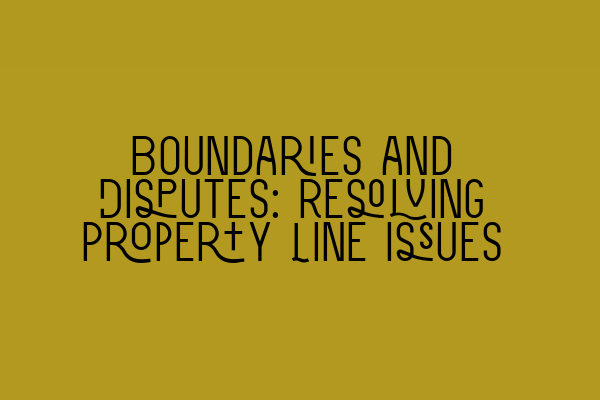Boundaries and Disputes: Resolving Property Line Issues
When it comes to property ownership, one of the most common issues that arise are disputes concerning property boundaries. These disputes can create tension and conflict between neighbors and can even lead to costly legal battles. It is important for property owners to understand their rights and responsibilities in order to effectively resolve these disputes.
Understanding Property Boundaries
Property boundaries are the lines that separate one property from another. They define the extent of a property owner’s land and are typically established through a survey. Boundary lines can be marked by physical structures such as fences, walls or hedges, or they may be described in legal documents such as deeds or title plans.
While property boundaries may seem straightforward, they can sometimes become a subject of dispute. This may be due to various factors, including:
- Unclear or ambiguous descriptions in legal documents
- Inaccurate or outdated surveys
- Disputes arising from adverse possession claims
- Encroachments or trespassing
Resolving Boundary Disputes
Resolving property line issues can be a complex and delicate process, requiring careful consideration of legal rights and remedies. Here are some steps that can help in resolving boundary disputes:
1. Communication and Mediation
The first step in resolving any dispute is to try and communicate with your neighbor. Engaging in an open and respectful conversation can often lead to a resolution without the need for legal intervention. If direct communication fails, you may consider seeking the assistance of a professional mediator who can help facilitate a resolution.
2. Examination of Legal Documents
Reviewing the relevant legal documents, such as deeds and title plans, is crucial in understanding the nature of your property rights. These documents may contain important information about the boundaries of your property. Consulting with a property law solicitor can provide you with the necessary guidance and advice.
3. Professional Survey
If there is still uncertainty about the property boundaries, obtaining a professional survey can help establish the accurate location of boundary lines. A surveyor will measure and map the property, taking into account any existing physical markers and legal descriptions.
4. Seek Legal Advice
If all other attempts at resolution have failed, it may become necessary to seek legal advice. A property law solicitor with expertise in boundary disputes can provide you with legal representation and guide you through the legal process. They can help you understand your rights, assess the strength of your claim, and represent your interests in court if required.
Conclusion
Boundary disputes can be highly contentious and emotionally charged, but with the right approach and the guidance of a knowledgeable legal professional, they can be effectively resolved. It is important to prioritize open communication and explore all possible avenues for resolution before resorting to litigation. Understanding the intricacies of property boundaries and seeking legal advice when necessary can protect your property rights and help you reach a satisfactory resolution.
For more information on related legal topics, we recommend reading the following articles:
